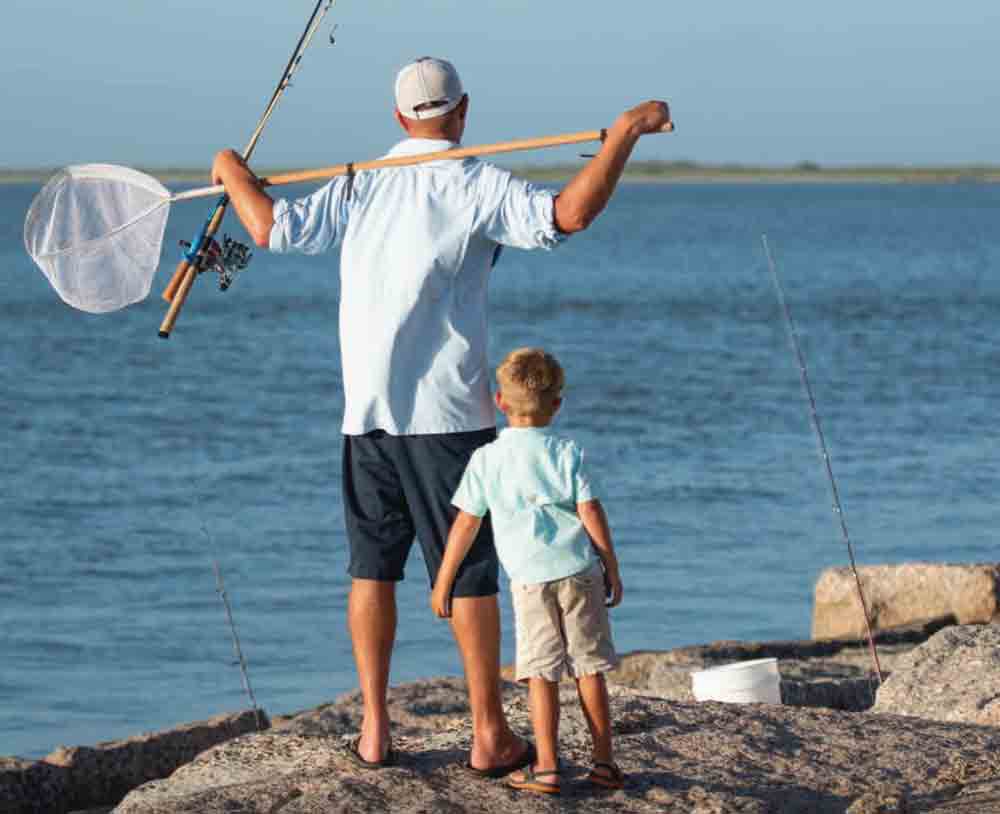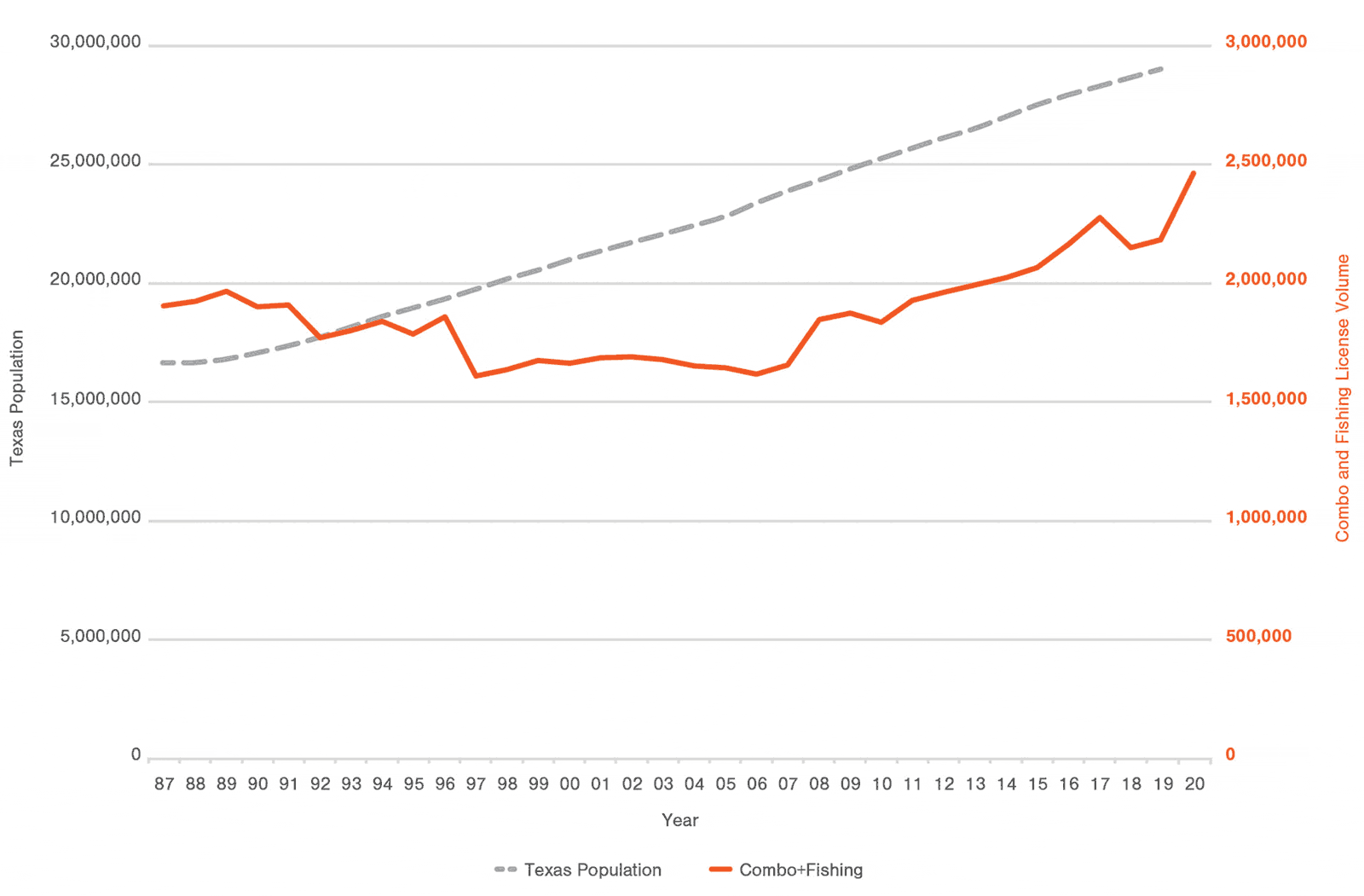Texas R3 Fishing Goals
Table of Contents
Skip to Goals
Fishing continues to be one of the most popular recreational pursuits in the United States, ranking second only to running, jogging, and trail running. Fishing attracted 49.4 million individuals six years of age and older in the U.S. (Recreational Boating & Fishing Foundation and Outdoor Foundation, 2019). Among youth, ages 6-24, fishing (including freshwater, saltwater, and fly fishing) ranked among the top five most popular outdoor activities with over 14 million participants (Outdoor Foundation, 2019).

Many anglers participate in other outdoor activities. Fishing is considered an outdoor “gateway” activity for youth and ranked second only behind running, jogging, and trail running in 2018 (Outdoor Foundation, 2019). Gateway activities are those that help introduce youth to other outdoor activities, and fishing is a low-cost alternative relative to other outdoor endeavors.
Fishing is a popular pastime in Texas. In the last two USFWS surveys of angling participation in the U.S. (2006, 2011), Texas ranked second to Florida in having the most anglers but ranked first in both years for having the most freshwater anglers. In 2015, over 1.2 million Texas fishing licenses were purchased, and of those anglers who purchased a license, 88% participated in fishing (Kyle et al., 2016). Of those 88% of anglers who participated in fishing in 2015, 78% participated in freshwater fishing and 62% participated in saltwater fishing (Kyle et al., 2016). The top reasons participants fish include exercise, to be with family and friends, to be close to nature, and to enjoy nature/scenic beauty. Work/family commitments, other leisure activities, and quality of fishing facilities and access were listed as the top constraints to fishing participation.
Fishing is also an important economic engine to the state economy. According to Southwick Associates, in 2011, the total economic impact of fishing in Texas was $3.6 billion and supported more than 29,000 jobs (Southwick Associates, 2013). From 2010 to 2016, resident millennial (ages 18-34 and the nation’s largest living generation) license revenues for both hunting and fishing grew at an average annual rate of about 11.9% (A. Farias, personal communication). However, the rapidly increasing Texas population is far out-pacing growth in fishing license sales. See Figure 2. TPWD needs to increase efforts to engage more Texans in fishing.
Figure 2: Texas combo and fishing license sales compared to Texas population, 1987-2020.

Note: In 2020, fishing license sales increased by 25% versus previous year. A large part of this increase can be attributed to the COVID-19 pandemic, which has given people more time and inclination to social distance and relieve stress by getting outside. With so many other activity options being limited, or unavailable, people have turned to hunting, fishing, boating, parks and other outdoor activities.
Outline of Fishing Goals
- Goal 1: Increase fishing license sales by 2% annually
- Objective: Reach participation goal in the RBFF 60 in 60 campaign (62,513 licenses each year, over the next three years)
Metric: License sales
Target Audience: First time, lapsed and active license buyers
Timeframe: Short-term, Ongoing
- Expand fishing access
- Improve existing fishing access sites (e.g., parking, restrooms, fish cleaning, lighting, safety, ADA access)
- Create more leased public river access areas to expand the number of river miles available for fishing opportunities
- Continue to apply for and provide third-party grant funding (e.g., USDA Voluntary Public Access and Habitat Incentive Program) for public access projects
- Use spatial technologies (GIS software, census data and other demographic databases) to focus access opportunities near target audiences (multi-cultural families, millennials, Hispanics, urban population centers)
- Provide opportunities, resources and social support, both online and in person, for first-time license buyers and lapsed license buyers to connect with fishing community in fishing activities
- Expand fishing access
- Objective: Reduce churn rate by 2% per year
Metric: Program evaluation, retention of current license buyers
Target Audience: Current license buyers
Timeframe: Short-term, Long-term, Ongoing
- Collaborate across TPWD divisions to develop and implement targeted marketing campaigns (e.g., direct mail, email, social media)
- Host locavore events (and other event types) and expand existing partnership with Central Market Cooking School to provide exciting opportunities to anglers that prevent current license buyers from lapsing
- Create and implement new programs and tools (e.g., RBFF lapsed angler tools) to prevent current license buyers from lapsing
- Develop a mentor program that includes best practices, tracking and evaluation (e.g., TPWD Youth and Adult Mentored Hunting Programs)
- Develop an application process that helps recruit mentors based on their interests and TPWD needs
- Recruit initially from existing volunteer instructors and consider partner instructors
- Objective: Simplify license-buying process and products
Metric: Survey license buyers for satisfaction
Target Audience: New, current and lapsed anglers
Timeframe: Short-term, Long-term, Ongoing- Implement a more convenient license and tagging system
- Develop and implement strategic plan to move toward a modern and simplified license acquisition and tagging system.
- Continue to develop and send license renewal emails, especially to first-time license buyers
- Develop and implement an auto-renewal license option
- Reduce and/or introduce more appealing/relevant license types per the 2016 fee analysis
- Implement a more convenient license and tagging system
- Objective: Recruit new anglers
Metric: Survey participation in the Neighborhood Fishin’ Program
Target Audience: New and lapsed license buyers that live in one of the metropolitan statistical areas (DFW, Houston, Austin, San Antonio)
Timeframe: Short-term, Ongoing
- Evaluate existing programs (see Cross-Program Goal 1.2) including but not limited to Outdoor Skills, Angler Education, Angler Recognition, and Sharelunker, and measure success
- Expand the Neighborhood Fishin’ Program
- Increase the number of sites as funding support allows
- Collaborate with partners to strategically develop a plan to expand the Neighborhood Fishin’ Program
- Continue to use tapestry segmentation to identify and target customer groups
- Objective: Recruit, retain and reactivate anglers through management and promotion of close-to-home (within 30 minutes) fishing opportunities
Metric: License sales, and customer awareness, use, and satisfaction of resources
Target Audience: New, current and lapsed anglers in both inland and coastal urban areas
Timeframe: Long-term, Ongoing
- Identify and prioritize suitable local fishing opportunities
- Develop promotional/educational materials that would make these fishing opportunities easily accessible to new or novice anglers
- Collect contact information for participants allowing the department to continue engaging with current and future customers
- Partner with RBFF in their Adopt a Lake and/or Adopt a Stream programs
- Objective: Reach participation goal in the RBFF 60 in 60 campaign (62,513 licenses each year, over the next three years)
- Goal 2:Recruit, retain and reactivate new anglers
- Objective: Develop a campaign to reach new customer groups (especially millennials, women, Hispanics and people with disabilities)
Metric: Customer participation, buying behavior
Target Audience: High growth potential groups Timeframe: Short-term, Ongoing- Develop strategic plan for recruiting and retaining new customers
- Create and test tailored messaging
- Utilize and, when necessary, create more “social networks” around fishing
- Create and evaluate a fishing mentor program
- Engage partners to help with mentoring
- Continue the Tackle Loaner Program with State Parks and external partners to recruit new customers, retain and reactivate current and past customers
- Pilot a Tackle Loaner Program with school campuses to reach new and non-traditional customers
- Offer specialty classes (target species or specialized equipment) to retain and reactivate anglers
- Develop strategic plan for recruiting and retaining new customers
- Objective: Expand locavore program
Metric: License sales and program participants
Target Audience: Foodies, millennials
Timeframe: Short-term, Ongoing- Expand current cooking classes (e.g., Central Market) to include additional opportunities including a fishing outing for the chefs
- Expand online content dealing with wild-caught fish (recipes, etc.)
- Incorporate cooking into multiple fishing recruitment activities
- Objective: Develop a campaign to reach new customer groups (especially millennials, women, Hispanics and people with disabilities)